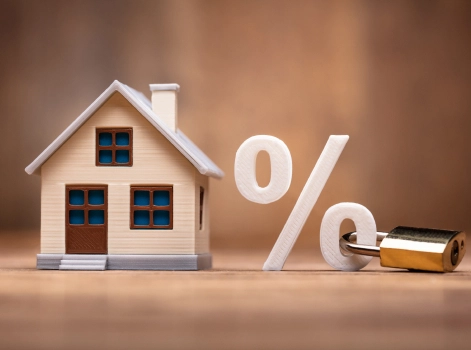When you apply for a home loan, banks won’t simply assess your borrowing capacity based on their standard variable rate.
They will assess you at a higher “floor” rate as a way of mitigating their risk if interest rates were to suddenly rise.
This can have a serious impact on your ability to borrow the amount you need but not all lenders apply the same serviceability rules.
How Does The Assessment Rate Work?
Decisions on bank Standard Variable Rates (SVR) are driven by changes to the Reserve Bank of Australia (RBA) cash rate.
The bank will then normally add an extra 2-3 percentage points to the official cash rate in order to arrive at their SVR.
This is to cover their cost of funding the loan plus a margin so they can earn a profit.
Obviously, the risks associated with your application will also determine the margin applied to your interest rate.
How Does The Assessment Rate Affect My Borrowing Power?
When assessing your ability to afford your home loan repayments or “serviceability”, most lenders will also add an extra buffer known as a benchmark assessment rate or floor rate.
This will typically be 2-3% above the bank’s SVR and it’s applied when assessing a customer’s income and asset position for serviceability.
The reason that the assessment rate is applied is to determine whether you could still make your mortgage repayments in the event that interest rates were to rise.
Think of it like an earthquake test for your financial situation.
Which Interest Rate To Settle For?
Your Guide To Finding The Interest Rate That’s Your Best Match

Disclaimer: Over the next few days, you’ll receive additional guides to help you on your homebuying journey. Occasionally, you’ll receive carefully curated home-buying tips, offers & schemes, and news articles. You can unsubscribe any time you want. View our Privacy Policy
Banks Don’t Publish Their Assessment Rates
Assessment rates or floor rates aren’t known to the general public so it can be very easy for applicants to fail the bank’s serviceability test.
That’s because banks don’t advertise them!
For example, a single borrower with an annual before tax income of $90,000 (and no debt for simplicity) can borrow up to $534,612 when assessed at 7.25% (P&I 30 year loan term). However, the same borrower when assessed at 5.05% can now borrow up to $653,100 – a boost in borrowing power of $118,488.
For some borrowers, this represents them getting approved for a home loan over being knocked back.
By speaking with a specialist mortgage broker, we can help you choose a lender that will allow you to borrow the amount you need.
Please call us on 1300 889 743 or complete our free online assessment form today.
APRA Assessment Rate: What Has Changed?
In October 2022, The Australian Prudential Regulation Authority (APRA) announced that it will increase the interest rate buffers that it advises banks to use to assess the serviceability of home loans from 2.5% to 3%.
APRA increased the buffer rate to keep debt-to-income ratios from getting too high and minimise the risk to the economy.
In July 2019, APRA finalised the following changes:
- Removed the previously mandated 7% serviceability floor rate. Banks are now free to set their own minimum floor assessment rate.
- Increased the buffer rate that’s applied to your home loan rate from 2 percentage points to 2.5.
This means lenders can now use the higher of the two rates – either the minimum floor rate or your interest rate plus the 2.5 percentage point buffer to assess your application.
With interest rates at record lows, you could easily be assessed at 5% to 7% instead of the previous uniform floor rate of 7.25%.
This is a major boost to the maximum borrowing power of borrowers with:
- First home buyers seeing their borrowing power increase by as much 22% approximately.
- Investors can now borrow 15% – 30% more than they could before.
Also, in 2020, with the proposed responsible lending changes, the banks may get a bit more lenient with serviceability around living expenses as well.
Customers who were declined in the past may get approval, or they may get approval for a larger loan amount because the banks are actually more flexible around what they’re actually spending.
Not All Lenders Are The Same
Not all lenders have the same serviceability test and apply the same floor rate buffer!
The big difference is for property investors since your existing debts may actually be assessed using an even higher assessment rate.
Where the actual interest rate is used to assess your serviceability, you can borrow more.
So which lenders don’t use a floor rate?
The rules around assessment rates only apply to ADIs like banks and certain major lenders.
There are a number of non-bank lenders that won’t necessarily apply a floor rate when assessing your application.
That’s because they don’t fall under the jurisdiction of APRA.
Floor-Rate Mortgage Case Study
Jeremy and Linda are both high school teachers earning $70,000.
They need a $500,000 home loan to buy their very first home.
They currently have a credit card with a $20,000 limit and they’re paying $488 a month for a $25,000 car loan.
Other than that, they’re debt-free and feel like they’re in a position to borrow the amount they need.
Their bank is offering a competitive variable interest rate of 3.69% so they decide to apply.
Based on that interest rate and loan amount, their actual monthly repayments will be around $2,299.
However, when assessing their application, the bank applies a floor rate, bringing the couple’s assessment rate to 7.85%.
Effectively, the bank wants to know if they can afford to make their mortgage repayments when paying $3,617 a month.
That’s the same as borrowing $800,000 over 30 years when they’re only wanting to borrow $500,000!
Because the floor rate has been applied, Jeremy and Linda are declined by their bank.
However, the couple are currently using much less than their $20,000 credit limit allows them.
If they were to pay down their credit card and reduce their limit to $10,000, they would be able to qualify for their $500,000 home loan.
How Do I Work Out My Borrowing Power?
There are three different methods that lenders use to calculate your serviceability:
- Net Surplus Ratio (NSR).
- Debt Servicing Ratio (DSR).
- Surplus / Uncommitted Monthly Income (UMI).
They differ in how they weigh up your income and expenses, and the way they display the result.
The DSR method was commonly used in the past but it’s now considered to be inaccurate for property investors or for people earning over $200,000 or under $30,000.
Discover your borrowing power with the How Much Can I Borrow? calculator.
You can also get an idea of your monthly repayments by using our mortgage repayment calculator.
Our Brokers Are Here To Help!
We can assess your situation for free and give you an indication of how much you can afford to borrow.
All you have to do is give us a call on 1300 889 743 or complete our free assessment form and tell us a little about your situation.
